Martello Towers - Other

The Martello Tower is situated on the south coast of Barbuda. It was built in the early 1800s as a defense base for the British, to stand guard over the river landing, the island’s original quay.
The current fort was erected on the site of a preexisting fort, presumed to have been built by the Spanish, dating back to 1745.
The tower is located on the south coast of the island, a mile or so from River Landing and some seven miles south of the island's main village of Codrington. The tower is 56 feet high, has a raised gun platform and extremely thick walls, but is missing the floors.
The fort, which was once armed with three guns, is placed near a small stream which only appeared in wet weather.
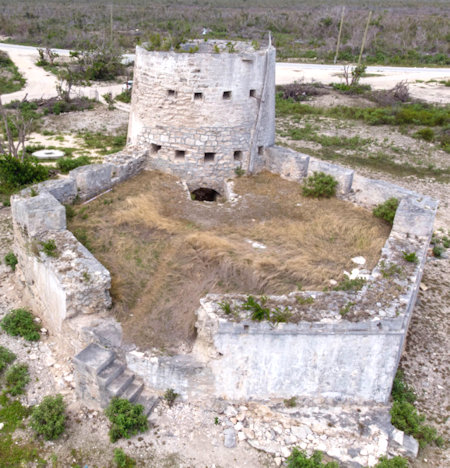
It the first such tower constructed in the Caribbean, was built in 1745 by Sir William Codrington, and was designed by Commodore Charles Knowles RN, later Admiral Sir Charles Knowles Bt, who was then commanding the Leeward Islands station.
It is attached to what remains of the pre-existing fort. 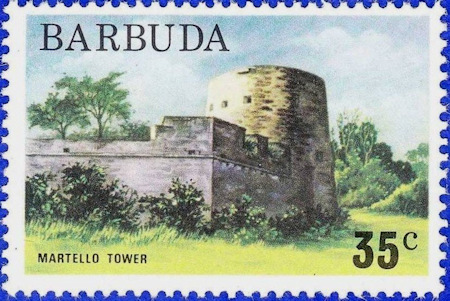
The tower mounted three cannon, and in all the
fort mounted ten cannons, none of which remain. The tower is the highest building on Barbuda and serves as a daymark from land or sea.
Today the fort is a popular location for weddings.
Sri Lanka
The only Martello Tower in Sri Lanka is located at Hambantota and is one of the rarest monuments in the world, as it remains to be the smallest and only type of fortification that was built by colonials.
Set on top of the ruins of a Dutch fortress, the British constructed this particular type of fortress to protect the seaport town from attacks, especially after the Kandyan forces’ rebellion.

The tower was completed in 1803 and was believed to have housed a garrison of 15-25 men along with an officer, and several artillery weapons to repel any sort of future attack.
The Martello Tower stands at a height of 25ft, which allows for a 360-degree clear line of sight if any invader were to attack the area. Ever since the country gained its independence in 1948, the tower was rendered obsolete.
However, it has been restored recently and now is an archaeological site which also houses a fisheries museum.
There is one Martello Tower in Australia.
There was only one Martello Tower built in Australia, Fort Denison. It was built in 1857 on an island in Sydney Harbour and was the last Martello tower ever built in the British Empire.
In 1839, two American warships entered the harbour at night and circled Pinchgut Island. The concern with the threat of foreign attack caused the government to review the harbour's inner defences.
Captain George Barney, the civil engineer for the colony, had earlier reported that Sydney’s defences were inadequate, recommended that the government establish a fort on Pinchgut Island to help protect Sydney Harbour from attack by foreign vessels.
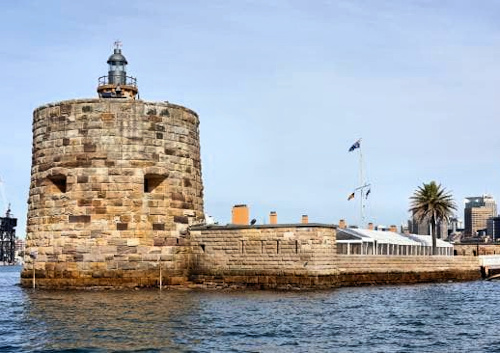
Fort Denison Today
Fortification of the island began in 1841 but was not completed. Construction resumed in 1855 because of fear of a Russian naval attack during the Crimean War and was completed on 14 November 1857. The newly built fort then took its current name from Sir William Thomas Denison, the Governor of New South Wales from 1855 to 1861.
However, developments in artillery rendered the fort largely obsolete by the time it was completed. The tower itself had quarters for a garrison of 24 soldiers and one officer. Fort Denison's armament included three 8-inch (200 mm) muzzle loaders in the tower, two 10-inch (250 mm) guns, one on a 360-degree traverse on the top of the tower and one in a bastion at the other end of the island, and twelve 32-pound (15 kg) cannons in a battery between the base of the tower and the flanking bastion.
In 1978 the former fortress was listed on the Register of the National Estate, and is now used as a national park, nature reserve, tourist facility, and as a function space.
There is a Martello tower located at Ferry Reach in St George's Parish. The tower is the third fortification on the site. Major Thomas Blanshard built it of Bermuda limestone between 1822–1823.
The tower shows the effect of thirty years of evolution on the design of coastal fortifications, between the 1790s and 1822. The earlier Ferry Island Fort nearby had multiple guns arrayed to cover the water westward, while the Martello tower used a single gun with 360° traverse to cover all of the surrounding area.
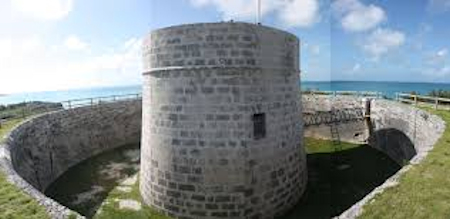
Martello Tower in Bermuda
Like its predecessors in the UK, it has an ovoid footprint with the thickness of its walls ranging from nine to 11 feet. It is surrounded by a dry moat. The tower's purpose was to defend the Ferry Reach Channel and so impede any attack on St. George's Island from the main island of Bermuda, and attacking vessels from slipping through Castle Harbour and the channel between Ferry Reach and Coney Island. The main channel by which vessels reach most parts of Bermuda west of St. George's, including the Royal Naval Dockyard, on Ireland, the Great Sound, Hamilton Harbour, The Flatts, Murray's Anchorage, and other important sites, carries them around the east ends of St. David's and St. George's Islands, where the coastal artillery was always most heavily concentrated. Two more Martello towers to protect the Dockyard were planned, but never built.
The tower was restored in 2008 and an 18-pounder cannon brought from Fort St. Catherine was mounted on top.
The was one Martello Tower built on the British Virgin Islands, Fort Recovery on the West End of Tortola. In historical records, the fort is often referred to as Tower Fort, and the area around the fort is still referred to as "Towers" today.
The site was originally an earthen fort that was probably built by the Dutch privateer Joost van Dyk in 1620, when the truce, which had existed between the Dutch and the Spanish in Puerto Rico, ended.
Somewhere between 1623 and 1630, Fort Recovery may have been used as a barracks for wounded and ill soldiers; this is probably the source of the name "Fort Recovery".
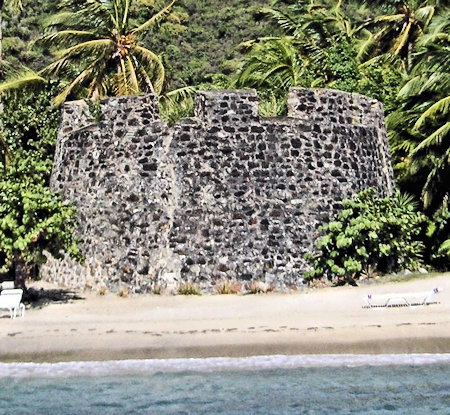
Fort Recovery
The Fort was later abandoned when the Territory fell into decline after the British seized control of the islands in 1672. However, during the turbulent colonial-era commencing with the American Revolutionary War and extending to the Napoleonic wars the fort was rebuilt in its current form.
When the British rebuilt the fort, the Martello Tower was clearly added to try to compensate for the lack of elevation of the cannon at the Fort.
The fort fell into disrepair again in the early 19th century when the main theatre of conflict moved from the colonies to mainland Europe, and the economies of the islands were insufficient for its upkeep. It may also have been that if the fort was designed to protect a source of fresh water when the source dried up ( the necessity for the fort disappeared.
In 1823, a design for a Martello Tower was approved in the southwest part of Puerto Rico in the town of Cabo Rojo.
Below is a copy of the original drawing. According to the historical record, the Tower to be constructed was 35 feet high with a garrison of 4 small cannons (barbette).
It is not known if the tower was built but it as an example of a Martell Tower in the Spanish Caribbean.
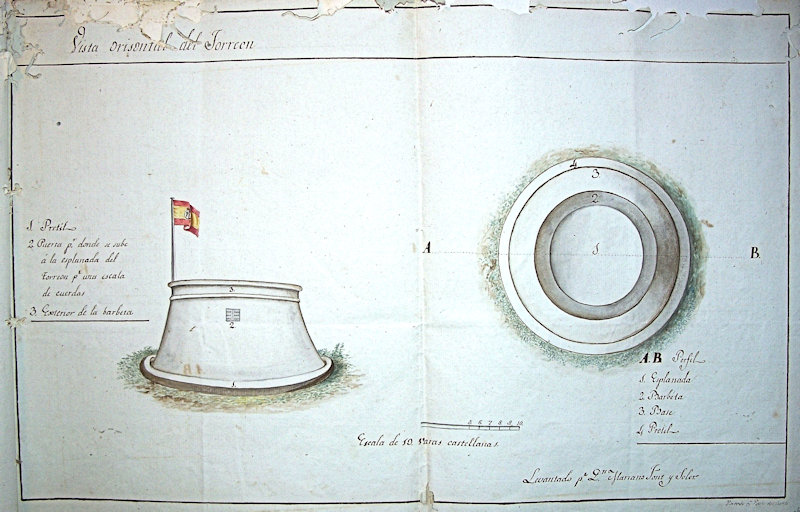
1823 Plans for Martello Tower at Cabo Rojo on Puerto Rico





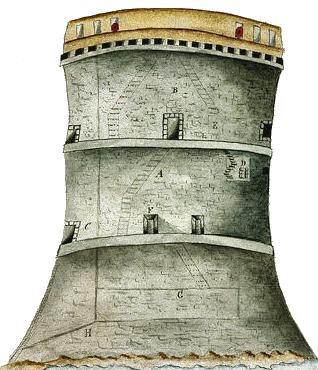


 Red Dragon I.T. Ltd.
Red Dragon I.T. Ltd.